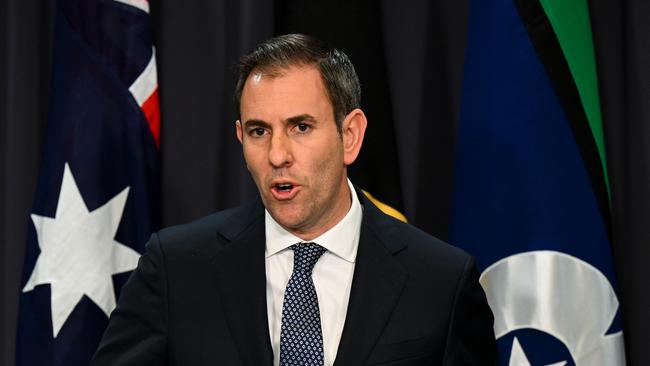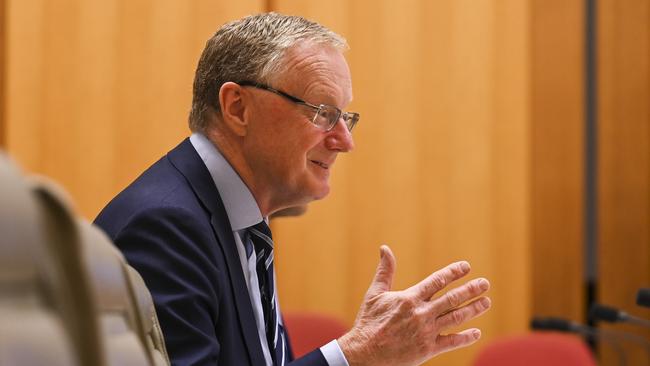Pain, blame and, at this rate, it’s not over
The central bank has raised rates for a twelfth time, piling further pressure on household budgets and the economy.
The Reserve Bank has warned embattled mortgage holders of more pain to come, after the central bank increased interest rates for a 12th time in just over a year to 4.1 per cent and flagged it had become more worried that inflation would not be brought under control without further hikes.
Jim Chalmers moved to shield the government from the political fallout over a string of interest rate increases since Labor took power in May last year, saying there would be “a lot of Australians who will find this decision difficult to understand and difficult to cop”.
Conceding it would be difficult for the RBA to “squash inflation without crashing the economy”, the Treasurer rejected claims from business groups and the Coalition that spending in the May budget and last week’s large pay increase for low-paid workers were to blame for the latest rate hike.
With homeowners now enduring the heaviest debt burden since at least the early 1980s, Dr Chalmers said: “Ordinary working people are already bearing the brunt of these interest rate rises; they shouldn’t also bear the blame.”

Ahead of RBA governor Philip Lowe’s speech at a conference in Sydney on Wednesday morning, Dr Chalmers said the RBA would have “lots of opportunities of course to explain and defend the decision that they’ve taken today”.
As the ACTU accused the central bank of being “hell bent on crushing consumers” and claimed corporate greed was to blame for high inflation, the Australian Chamber of Commerce and Industry said the Labor-backed decision to deliver a 5.75 per cent increase to minimum and award wages had “forced the hand of the Reserve Bank”.
“Despite the Fair Work Commission’s attempts to downplay the implications of its award wages decision on inflation, the risks of broader benchmarking in other wage agreements through the rest of the labour force must be recognised,” said ACCI chief executive Andrew McKellar.
Opposition Treasury spokesman Angus Taylor accused the Albanese government “of not taking the fight against inflation seriously” and argued spending in the May budget contributed to the rate hike. “This decision, this rate hike, has made it very clear that the budget did nothing to fight inflation,” Mr Taylor said.
“Labor has been in government for a year. It’s delivered two budgets now. And the truth of the matter is that they are forcing the Reserve Bank to do the heavy lifting.”
Dr Lowe said last week the May budget’s impact on inflation was “broadly neutral”.
With the government facing pressure from the Greens to provide more assistance to renters, the Treasurer demanded property investors and businesses not use the cover of climbing interest costs to “profiteer” from their customers and tenants.
“We don’t want to see people profiteering,” Dr Chalmers said.
“We don’t want to see people gouging. People are under enough pressure as it is without landlords or others doing the wrong thing by (working people).”
With the RBA locked in what it fears could be a losing battle to bring inflation back under control and to its 2-3 per cent target range by mid-2025, Dr Lowe, in a statement, recognised that some Australians were “experiencing a painful squeeze on their finances”.
But the under-fire governor said: “This further increase in interest rates is to provide greater confidence that inflation will return to target within a reasonable timeframe”.
The cash rate is now at its highest since 2012, and Dr Lowe said the board now saw the risk of inflation staying higher than anticipated and warned of further interest rate increases over coming months.
“Some further tightening of monetary policy may be required to ensure that inflation returns to target in a reasonable timeframe, but that will depend upon how the economy and inflation evolve,” the RBA governor said.

The latest rate rise, once passed through to the roughly 3.3 million households with a mortgage, will add $114 to the monthly repayment on a $750,000 home loan, bringing the total increase to $1701 in a little over a year. A family with a $500,000 mortgage will be paying a total of $1134 more on their monthly repayments, including an extra $76 from Tuesday’s decision, according to RateCity.
The Australian revealed that the average indebted homeowner would be dedicating a record 25 per cent of their take-home pay to meeting their mortgage obligations – up 50 per cent on a year earlier.
“Inflation in Australia has passed its peak, but at 7 per cent is still too high and it will be some time yet before it is back in the target range,” Dr Lowe said.
“The board remains alert to the risk that expectations of ongoing high inflation contribute to larger increases in both prices and wages, especially given the limited spare capacity in the economy and the still very low rate of unemployment.”
From virtually zero in April last year, the RBA board has delivered 12 increases to its key cash rate as it battles to regain control of generationally high inflation without dragging the economy into recession.
Dr Lowe signalled that the central bank had become more concerned that it would not be able to bring consumer price growth back to its 2-3 per cent target range by mid-2025, as he warned: “If high inflation were to become entrenched in people’s expectations, it would be very costly to reduce later, involving even higher interest rates and a larger rise in unemployment.
“Recent data indicate that the upside risks to the inflation outlook have increased and the board has responded to this.
“While goods price inflation is slowing, services price inflation is still very high and is proving to be very persistent overseas.
“Unit labour costs are also rising briskly, with productivity growth remaining subdued.”
EY chief economist Cherelle Murphy said “with inflationary pressures lingering, as labour productivity growth falls and wages rise, there is still a case for tighter monetary policy to come”.
KPMG chief economist Brendan Rynne said the RBA was keen not to fall behind the curve, given consumer price pressures were proving stickier than feared.
“It is clear that the RBA is most concerned about the risks of inflation expectations becoming entrenched, and fears that if it waited a couple of months to act – as recent economic data gave it reason to – it could miss the boat and then be forced to raise rates even higher,” Dr Rynne said. “It has therefore decided to go hard and go early.”
Economists said Wednesday’s national accounts figures should show a moderation, but not a collapse, in economic growth through the first three months of this year. But that good news would be tempered with further evidence that unit labour costs – a key measure of inflation-linked pay pressures – has accelerated.
Dr Lowe in his statement said the board was “still seeking to keep the economy on an even keel” as inflation returned to the target range. But he added “the path to achieving a soft landing remains a narrow one”, and a significant source of uncertainty was the outlook for household consumption. “The combination of higher interest rates and cost-of-living pressures is leading to a substantial slowing in household spending,” he said.
“Housing prices are rising again and some households have substantial savings buffers, although others are experiencing a painful squeeze on their finances.”
Dr Lowe in his statement said the board was “still seeking to keep the economy on an even keel” as inflation returned to the target range. But he added “the path to achieving a soft landing remains a narrow one”, and a significant source of uncertainty was the outlook for household consumption. “The combination of higher interest rates and cost-of-living pressures is leading to a substantial slowing in household spending,” he said.
“Housing prices are rising again and some households have substantial savings buffers, although others are experiencing a painful squeeze on their finances.”







To join the conversation, please log in. Don't have an account? Register
Join the conversation, you are commenting as Logout